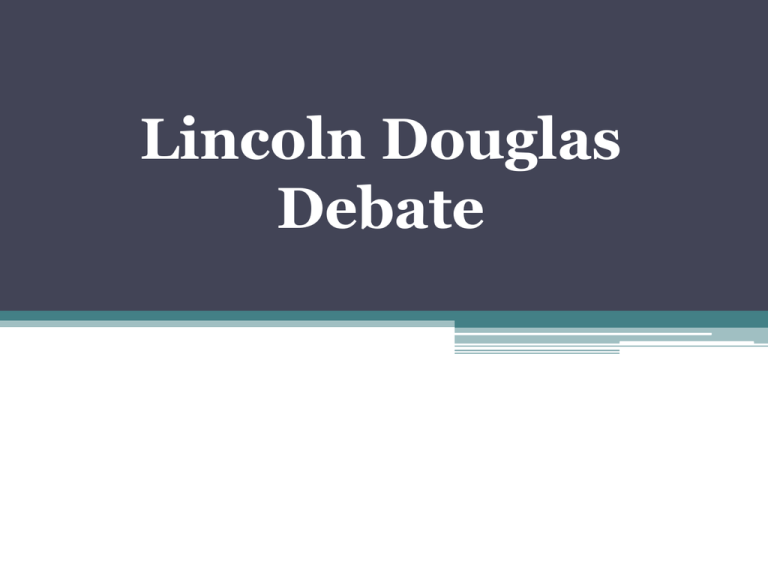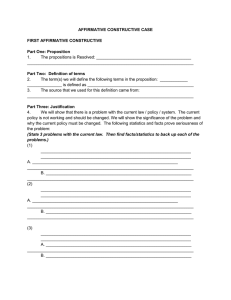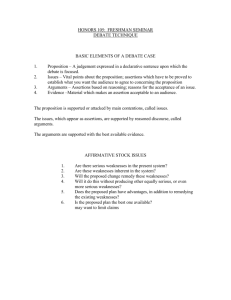Types of Debate
advertisement

Lincoln Douglas Debate History • In 1858 Abraham Lincoln challenged his opponent for the U.S. Senate, Stephen Douglas, to a series of debates. Douglas accepted and there was a spectacle in 7 cities, complete with cheering crowds and brass bands. • The issues were state rights and slavery. As a result of this “clash,” 2 person debates on a proposition of value are called Lincoln-Douglas debates. • Political candidates continue to use this backand-forth speech format. It communicates their clash of ideas on important issues of the day. L-D Debates • L-D Debates are different than the last type of debate we completed (Policy Debates) in 2 key ways. (value and 1 on 1) • However, the principles of research, argumentation, evidence analysis, case preparation, and rebuttal that were discussed during our last debate apply to L-D debates as well. (Side Note) • Due to the nature of the ideas/concepts in an LD debate, style, especially your delivery, is one of the most important parts of your debate. • Meaning, how you speak and deliver your side is the biggest portion of your debate grade. Debating Propositions of Value Difference in How You Argue • Because L-D arguments hinge on propositions of value, which are neither right nor wrong, you will find it necessary to argue less from statements of fact (This is right. They are wrong. This evidence proves I am right.) and more from evidence that provides philosophical support for value preferences. (philosophy = rational investigation and critical study of something) • Your ability to convince a judge of the merit of your arguments is less about how much evidence you use than about how you present statements of value and how you support the values you offer in the round, both through evidence and logical analysis. Making Sense of This • To debate L-D topics, you must understand what values are and how they affect our lives and decisions. • Also, remember that values are neither right nor wrong. They are descriptions of what is preferable or ideal. • LD is more conceptual, and real-life examples may illustrate some philosophical truth, but may not necessary “prove” it. • Which makes more sense to the audience and is the more logical/philosophical choice? • We all have a set of values that come from the social, political, and religious influences in our lives. Personal, professional, and political conflicts often occur between people because people hold different values or prioritize their values differently. • Just because you disagree with someone doesn’t mean their opinion/value judgments are wrong. Value Proposition • A proposition of value declares some judgment about some reality. • A value declaration requires that the debater determine and support the reality as well as determine and support the reasonableness of the judgment. Example • “The temperature is too hot in this room” is a proposition of value. • It should be obvious that everyone debating this proposition must agree upon the temperature and the room – which may be open to debate. • However, we must also pursue the correctness of the judgment declared. What is “too hot?” You must establish a standard of judgment. • Then, ask “too hot for what?” We must argue against a standard. “Too hot to boil water?” “Too hot to freeze something?” “Too hot for school?” • A value judgment is not just a matter of personal opinion – don’t be mistaken. • Arguments (in the previous scenario) can be made as to appropriate standards of judgment. • Then, arguing the temperature to the standard can result in a strong case. • Notice: propositions of value cause debaters to argue both facts (material truths) and values (appropriate standards of judgment). And the debate doesn’t end there. • The debaters must also argue how the facts measure up against the standards of judgment. Another Example • You cannot decide that your wristwatch is worth more than my watch until you agree upon the standard with which you establish its worth. • If the standard of judgment is dollar value and mine is plastic and was free with my new running shoes and your watch is an antique Rolex. Yours is worth more. • However, what if we both need to be at the airport on time? My watch keeps great time, while your Rolex has not kept time for the past fifty years. My watch is worth more than yours if telling time is the standard of value. Standard • If we cannot agree upon an appropriate standard, then we have to argue over what standard is the more appropriate for deciding the worth of wristwatches. • That may be an argument that is difficult to decide. • I may argue that the essential nature of watches is as a timepiece, and that telling time is the best way to judge the value. To that, monetary value is secondary. • You may argue that both watches have the same purpose and yours can be repaired - and that the ultimate worth of something is the accumulation of all of its potential values. Your watch may not tell time, but it could if fixed. Add that to the monetary value and yours is the most valuable. • How would an objective judge decide this debate? • It would depend upon which of us seems most reasonable in arguing the appropriate standard of judgment. Values are Categorized as: • Moral or ethical: judgments about right/wrong or good/bad • Artistic: what is beautiful or ugly • Pragmatic or Practical: what is practical or efficient • Political: principles such as democracy, justice, etc. Core Value • To defend or reject a proposition of policy (last debates) requires a standard of judgment against which the “facts” are compared. • The standard of judgment in value debate is the core value. • The core value is often implicit within the context of the proposition; for example, “Individual rights are more important than social order.” • Implicit in this topic are core values such as freedom, liberty, safety, etc. Core Value Cont’d • A debater upholding the importance of individual rights might argue that liberty would be secured by the value judgment, and that liberty is of utmost importance. • A debater rejecting the proposition might argue that upholding liberty above all else would be an endorsement of anarchy and chaos. • The case for rejection might argue that stability is essential to the survival of society, and therefore social order is of greater importance than individual rights. • The rejection might argue further than unless stability can be guaranteed, liberty is meaningless if not impossible. So – social order may be necessary for liberty to be meaningful. • Both sides could argue the core value of “liberty.” • Either way, core value is the standard argues to be of utmost importance when trying to decide the truth of the value judgment. • Since you are trying to advocate your side of the proposition, you choose a core value that you think most people would accepts as an assumed value to society and one that your side of the proposition uniquely upholds. As far as our debates go • We hold many values, and at time one value conflicts with another. • When this happens, we must decide which is more important. • In doing this, we establish a hierarchy or ordering of our values. • You are proving that your value judgment goes above the others, thus saying your side should win. Value Criteria • When you are arguing that liberty is being met by upholding the proposition that individual rights are more important than social order, you find yourself explaining what constitutes liberty, its elements, and its conditions. • This explanation is important. • Value criteria are the measures by which the facts of individual rights are compared with the standard of judgment, which is liberty. • Generally speaking, value criteria are the measures by which the facts of the value proposition are said to uphold the core value. • Different types of value propositions demand different considerations for both core values and value criteria. Common Values Debated • • • • • • • • • • • Achievement Democracy Equality Freedom Justice Liberty Life Privacy Progress Pursuit of Happiness Security • Lincoln Douglas debates allow for analysis to determine how values are ordered and how they should be ordered. • Though neither side is necessarily right or wrong – one side will analyze the issue better and state why it is more important to agree with them and why their side makes “more” sense. Two Forms of LD Topics (Types of Value Propositions) 1. The first is more common and asks for the resolution of judgmental declarations or statements of fact. For example: “Resolved: That government limits on a right to bear arms in the US is justified” 2. The second is purely philosophical and calls for comparison of two “core”/”terminal” values. For example: “Resolved: That liberty is preferable to life” First Option (Single Entity) • “Resolved: That government limits on a right to bear arms in the US is justified” • First, you will define the terms in this topic. The debate over this topic will center upon the values of society that are upheld by such laws. • A case to reject this resolution will focus on precious values that are compromised, limited, or denied by such laws. First Option (Single Entity) Cont’d • To support the resolution, an appropriate core value might be the protection of public welfare. The value criteria might be duty or safety. • The appropriate value criteria depends upon the core value: safety may be important for measuring the protection of the public welfare; fair administration of laws may be the test for justice, and duties fulfilled may be the criterion for determining whether social contract is met by government. • The case upholding the resolution could argues that laws that protect citizens from themselves are justified because they promote safety (the value criterion), which is necessary for gaining the protection of the public welfare (the core value) Second Option: Comparison Between Two Entries • “Resolved: An oppressive government is more desirable than no government.” • A value proposition that declares a judgment of comparison between two entities requires a different approach. • This declares that between two separate conditions, items, or ideas, one is to be preferred over the other. • You can compare in many ways: one has higher priority, one is more desirable, one is more important, one has greater value, etc… Cont’d • Definitions will be of first importance. What is meant by “oppressive” and what is meant be “no government?” • Then, again, decide on core values. • Decide on your value criteria. For example, laws and rules would be important for determining order and stability. • Aff. may say: while laws can be restrictive, it’s necessary for stability – which is essential to stabilized society. • Neg may say: no government would mean no organized restrictions upon fairness and dissent, and while chaos might flourish with no gov., fairness and free expression would be worth the cost of avoiding cruelty and harshness. Burden of Proof • Burden of Proof means those obligations held by the debater initiating the argument. • In LD debates, the value proposition is not assumed to be a judgment that is right or wrong… so there isn’t a burden of “proof” • Instead, they have the job of arguing that the proposition is reasonable for anyone to believe. They have the burden of proving the reasonableness of the proposition. • The negative has the burden of proving it false or unreasonable. • However, this argument won’t decide the debate because neither is assumed “true/right.” It is a part of winning the debate. Burden of Rejoinder • The burden of rejoinder (or refutation) means the obligation to respond. • Both sides have the burden of rejoinder. They must respond and reply to the opposing side. • This means that in addition to presenting your case and your points, you must respond to what the other side said during their speaking time. • If you simply read what you wrote and your case, but don’t reply to the opponent’s claims – there is a lack of clash and you could lose the debate. Clash • You know what clash is – the interaction between both side. • You must do this during the debate – it is how one side is shown to be weak or to shine as strong. • Clash requires you to think on your feet. • So, when the affirmative goes first – the negative must present their case AND comment on the affirmatives when they speak. • Then, after the negative goes, the affirmative does the same. Time • • • • • • • Affirmative Constructive Cross-Examination by Negative Negative Constructive Cross-Examination by Affirmative Affirmative Rebuttal Negative Rebuttal Affirmative Rebuttal 6 min 3 min 7 min 3 min 4 min 6 min 3 min The long negative constructive allows for both constructive and rebuttal opportunities. While both debaters have equal time, the affirmative has one more speech than the negative.







